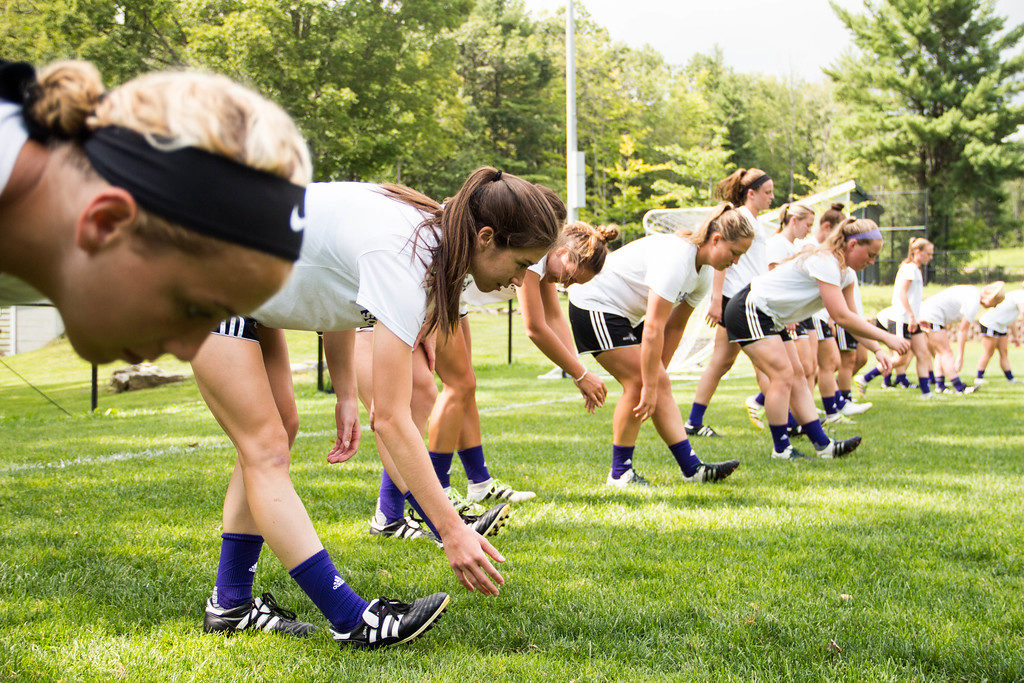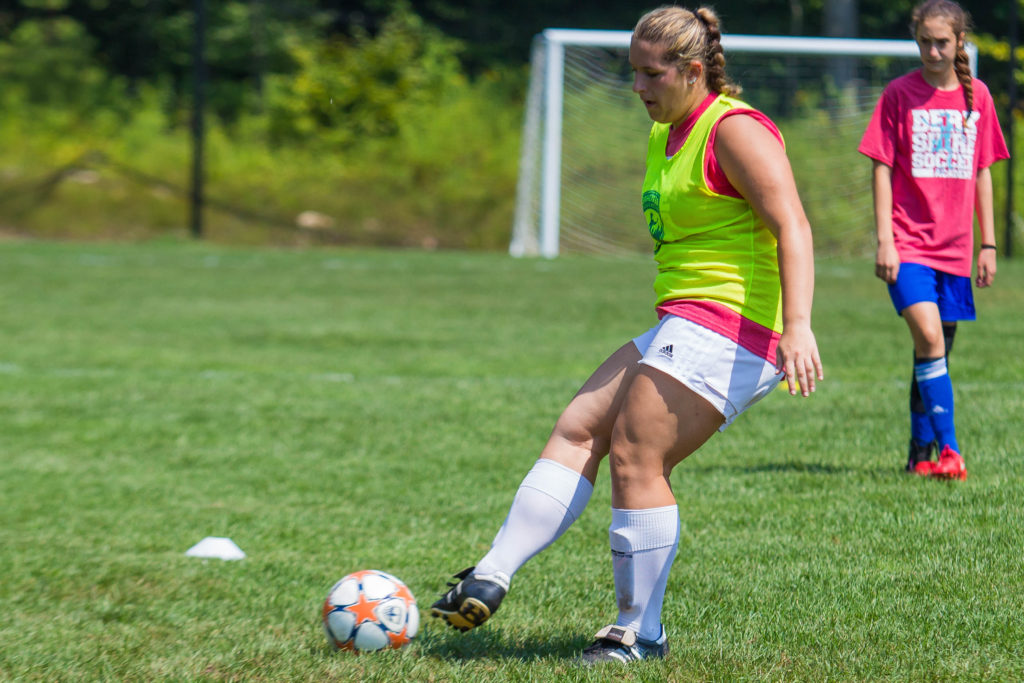Youth Soccer to College Scholarships
In the early stages of youth soccer, parents typically sign their kids up for soccer teams to provide them with fun, socialization and physical activity. As youth players develop into club and high school players, the reasons and objectives for participation in a sport often diversify. One likely goal many players and parents have is the pursuit of an athletic scholarship to play soccer at the collegiate level.
The Statistics Tell the NCAA Story of Athletes
The article below was written in 2008 by Dr. Jay Martin, Head Coach of the Ohio Wesleyan men’s soccer team, and Editor of the NSCAA publication, Soccer Journal. It addresses the statistical likelihood of receiving a soccer scholarship. The somber fact is that 96.6% of female high school soccer players will be offered $0.00 to play in college. How’s that for perspective? The silver lining, however, isn’t all that bad. There are numerous long-lasting benefits of playing soccer and pursuing excellence individually and as a team. The Complete Soccer Guide offers 7 Reasons to Play Soccer; and Teens Health sites 5 Reasons for Girls to Play Sports.
In the end, Dr. Martin recommends keeping it in perspective. Focusing on soccer’s life-long, character-building lessons will pay out far more and for far longer than an elusive sum of money.
“Center Circle” by Dr. Jay Martin
NSCAA Soccer Journal, 2008
In early March Bill Pennington wrote a four part series for the New York Times about DI athletics. With these two articles as an entrée, it seems like a good time to discuss the men’s and women’s soccer scholarship issue.
More and more players (and parents) believe it is worth investing several thousand dollars a year on select clubs, uniforms, showcase tournaments, elite camps, recruitment services and even private trainers to improve the odds of their offspring landing a soccer scholarship.
A recent survey of parents at the Jarosi Tournament in Columbus, Ohio revealed that more than 60 percent of parents view soccer at a “select” level as a means to a college athletic scholarship.
The father of a local U-12 player recently removed his son from a private school he attended for eight years. He plans to use the money he saves on tuition to pay for private trainers for his son. He wants to improve the chances of receiving a soccer scholarship.

Soccer Clubs Selling College Admissions
Advertisements for elite clubs, camps and recruiting services give the impression that signing on with them will increase chances for a scholarship. They seem to suggest that scholarships are there for the taking. A flyer from an elite club in Ohio, for instance, makes the claim that 80 percent of the club’s players receive soccer scholarships.College recruiting services routinely advertise that their service will improve a player’s chance of securing a college soccer scholarship. Alan Yost of the recruiting service NCSA said,
But a look at the facts suggests a far different picture of soccer scholarships. Critics say that select clubs often inflate the number of players who receive scholarships. And, many coaches throw away the information from recruiting services. They prefer to use their own sources and go to many tournaments to watch players. And, personal trainers have offered no data on the number of scholarship athletes they work with. So why do parents buy into the “scholarship sales pitch”?
While there is nothing wrong with using soccer to help a high school player get into one of the best schools – and perhaps get a scholarship – everyone involved should be realistic about the situation.
Men’s and Women’s Soccer Scholarship Statistics
A study in 1996 determined the following facts for the high school age soccer players:
– There were 8,182 boys and 6,500 girls soccer programs
– There were more than 283,700 boys and 209,000 girls playing high school soccer
– There were 51,066 boys and 37,620 girls who were seniors, played soccer and graduated
– There were 721 college programs for boys and 736 for girls
– There were 4,326 spots available on college teams for boys; and there were 4416 spots available for the girls
– There were playing opportunities for fewer than 8% of graduating seniors
– There were 433 scholarships for boys and 806 for girls
– Less than 1% of the graduating boys and around 2% of the girls received soccer scholarships.
How’s that for a dose of reality? But the good news is that in 2008 the situation is much better, right? Well not really.
There are more scholarships available for both men and women. But there are many more players playing the game in high school!
In Bill Pennington’s New York Times series, he discussed the scholarship situation for all NCAA sports. Pennington wrote,
“Excluding the glamour sports of football and basketball, the average NCAA athletic scholarship is nowhere near full tuition, amounting to $8,707. In sports like baseball and track and field, the number is routinely as low as $2,000. Even when football and basketball are included, the average is only $10,409. Tuition and room and board for NCAA institutions often cost between $20,000 and $50,000.”
Athletic or Academy Scholarships for NCAA Soccer Players?
Although the data compiled from the NCAA for the 2003-2004 academic year dealt with all sports, we will focus on men’s and women’s soccer. The article determined the following:
– Only about 2% of all NCAA DI athletes receive a scholarship
– There is no such thing as a four year scholarship. All scholarships are renewable annually
– There were 330,044 boys playing high school soccer and 270,273 girls
– There were 2,357 scholarships for boys and 3,964 for girls
– Those scholarships were awarded to 6,047 boys and 9,310 girls
– The average award was $8,533 for boys and $8,404 for girls – that means the men’s scholarship covered only 39% of costs and the women’s scholarships covered only 43% of costs
– Only 1.8% of high school soccer playing boys received a soccer scholarship and only 3.4% of the women received a soccer scholarship.
In the NYT article, NCAA President Myles Brand says, “The youth culture is overly aggressive and while the opportunity for an athletic scholarship is not trivial, it’s easy for the opportunity to be exaggerated by parents and advisors. That can skew behavior and based on numbers, lead to unrealistic expectations.”
The statistics above suggest that there is one NCAA scholarship for every 145 men who played soccer in college. Joe Taylor, a scholarship soccer player from Villanova, said,
“It is a huge dogfight to get whatever you can. Everyone is scrambling. There are so many good players, nobody understands how few get to keep playing after high school! If I had to do it over again, I would have skipped a practice every now and then to go to a concert or a movie with my friends. I missed out on a lot of things because of soccer. I wish I could have some of that time back.”
Parents and Athletes Should Know their Numbers
It is important that parents and coaches know these statistics and realize how difficult it is to receive a soccer scholarship. Although getting a soccer scholarship is a long shot, we do have some good news. Being a good soccer player may give an athlete an edge when colleges award academic scholarships and need based aid. In fact, there is much more money available to soccer players for academic prowess than for athletic excellence. An increased focus on academics will pay greater dividends than soccer excellence in the long run – it may also pay off on the short run.
A recent study by the College Board Association of Princeton, NJ determined that independent colleges in the United States award over $10 billion in financial aid each year. This includes awards from institutional funds for scholarships, fellowships and trainee stipends. Add state and federal financial aid funding and there is over $50 billion available for academic and need based aid each year!
The numbers say that soccer scholarships are relatively scarce. Should your players stop cracking shots and spend Saturdays cracking the books in a library instead? Of course not. We know that soccer is a great game. It has an important place in the life of your players – whether there is a soccer scholarship in the future or not. Everyone involved with soccer should just keep the scholarship issue in perspective. Your players should be playing for fun,, fitness, and the challenge of the game. If your players (and parents) are only playing to earn a soccer scholarship – maybe they should spend more time in the library!

Learn More
Check out the variety of programs for emerging and competitive girls soccer players offered at the Berkshire Soccer Academy. Our programs offer holistic development to our campers, setting them up for success on and off the field.
Learn More
Related Content
- Pyramid of Participation in Womens Soccer
- US Youth Soccer Overview – Youth Soccer Organizations
- ODP Tryouts
- ODP Process and Statistics of Participation









